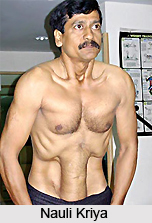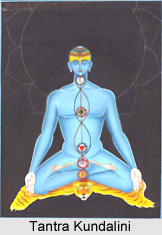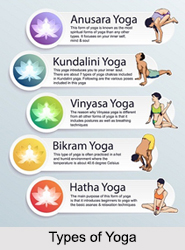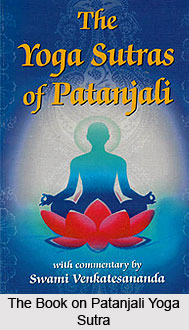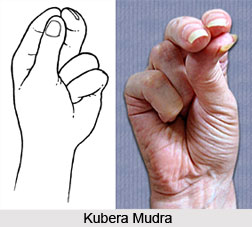 Mantra yoga indicates the chanting of a word or phrase until the mind and emotions are excelled and the super conscious is clearly exposed and experienced. Since human mind wanders into various mediums, the music and rhythm of a Mantra easily rescues the mind and brings it back to the object of one`s meditation.
Mantra yoga indicates the chanting of a word or phrase until the mind and emotions are excelled and the super conscious is clearly exposed and experienced. Since human mind wanders into various mediums, the music and rhythm of a Mantra easily rescues the mind and brings it back to the object of one`s meditation.
The history of Mantra Yoga dates back to Vedic Sciences and in Tantra, in fact all the verses in Vedas are called Mantras. It is said that any person who can chant or sing Vedas can achieve the final salvation or union with supreme consciousness only by chanting the Mantras. This is the sole objective of Mantra Yoga. Mantra is a Sanskrit word made up of two verbs, Man and Tra (Mananat Trayate in Sanskrit) that means, just by chanting one can save himself in the universe and can achieve the ultimate in this material world. The easiest and safest way to practice Mantra Yoga is to follow the path of pratyahara or sense withdrawal. Both the rhythm of a Mantra and the meaning combine, to guide the individual`s mind safely back to the point of meditation and the higher consciousness or the specific spiritual focus. Typical Mantrams to practise Mantra yoga are Aum, meaning Spirit, the Word of God, which creates, preserves, and transforms a human soul. The Tibetan Buddhist Mantram known as the Aum Mani Padme Hum, means "Om the jewel is in the Lotus Hum"; and Asato Ma Sat Gamayo means "Lead me from the unreal to the Real" are also important mantrams used in Mantra Yoga.
There are thousands of Mantrams, mainly in the ancient Sanskrit language to aid Mantra yoga. Mantra Yoga helps the person to get attuned to the Lord and also aids him to be at such an ease within the realms of higher consciousness that the Mantrams can easily be revealed to them. All Mantrams are the result of a revelation, usually when chanted by shiddha purushas (yogis). Generally Mantra Yoga involves chanting out loud at first until the body is calm and the atmosphere around is tranquil and pleasant for meditation. Then whisper meditation mechanically occurs and the life force begins to move inward from "out-loud" chanting to whisper chanting. In whisper chanting the prana or the life force in the body is evenly balanced and harmonized, preparing the way for a deeper state of tranquility and of the balance of mind and human emotions.
Whisper chanting easily dissolves and the life force travels even deeper within as one enter the realm of mental chanting. Mental chanting is practiced as long as thoughts are coming to the mind. Whenever the mind is distracted, the Mantra is simply chanted in the same part of the mind, where the distraction is occurring. The Mantra always wins if given a proper chance. As the Mantra frees the individual from one thought and also helps to dissolve distractions, it is the Mantra which then begins to reach the border of super consciousness. During Mantra Yoga no effort, nor warding off distractions, is required. Chanting becomes a pleasure and gradually peace and gentle joy fill the mind of the practitioner.
Mantra Yoga helps a person to get rid of old thoughts and feelings, old fears and guilts. After mental chanting becomes effortless, it ventilates the subconscious pressures and then moves into the super conscious self. Or, the effortless chanting bypasses the subconscious basement of the mind, going directly into the sublime super consciousness. Either way, the person arrives at the ecstatic and heavenly nature. The words of the Mantram fall apart and fall away. Only the energy surge of the Mantram remains as the awareness and the individual becomes blissful and full of light. In this ecstatic stage of continuous rapture of Mantra Yoga, the person feels completely at home and starts to sense his/her true nature, which has been ignored due to the dominance of the mind, the emotions, and the outer world.
Achieving Samadhi through rotation of consciousness is an important feature of Mantra Yoga. When a person chants Mantra, he/she is repeating the particular combination of words, which rotates the awareness of the person`s mind around the combination. This particular sound leads to the awakening of powerful inner force, if controlled properly this leads to ultimate salvation or union with super consciousness. Practicing Mantra Yoga means grouping of sound vibrations that shall affect mental and the psychological plane. Mantras are combination or grouping of various alphabets or "Akshar". The combined effect of sound vibrations on physical plane can be observed, especially on brain. Also Mantra Yoga affects the subconscious mind. It has different impressions on sub conscious; thinking patterns are affected; negative impressions are eliminated from subconscious such as fear, anger, jealousy and so on. Positive impressions can also be programmed in the subconscious mind through Mantra Yoga. Practice of Mantra increases concentration, memory and logical thinking; it also has soothing effect on nervous system, helps to relax the muscles and can be effectively used to reduce stress and its effects.
According to traditional belief one who uses the powers of Mantra Yoga for effecting evil and doing harm to others often runs the risk of self or the immolation and usually fall a prey to the wrath of the deity concerned. Those who employ these powers for selfish motives with the object of material gains to themselves at the cost of others, lose their power very soon, and finally ruin themselves. The powers of Mantra Yoga may be profitably used for the good of others and there is not much harm in that, though it may indicate loss of some fundamental energy after each such act. All types of miracles like thought- reading, thought-transference, faith-healing, particularly in cases of nervous and mental diseases are achieved through the intense practice of Mantra Yoga. Thus, it is always advised that one should use the powers of Mantra Yoga for gaining the spiritual planes and regions, which form the seat of the deities through a spirit of selfless devotion. Gradually the psychic powers gained by Mantra yoga will function by themselves without incurring any loss, even if one acquires them. However, one should remember that repetition of the Mantras does not bear any fruit unless it is done with full attention fixed on the specific Mantras.
Guru is the best judge of the disciple and he knows his disciples best to select the appropriate Mantra, which will help and evolve the disciple. The selection of Mantras also depends on the nature of the individual, his mind, physique and spiritual stage of development. For instance, Gayatri Mantra easily associates itself with sympathetic nervous system, so if a person is aggressive in nature and starts chanting Gayatri, he may start getting irritated early as Gayatri Mantra triggers sympathetic activities. Mahamrutyunjay is for the parasympathetic nervous system. Pouranic Mantra or the Om namah shivay, Hare ram Hare Krishna and Om namo narayan; are relatively simple and can be practiced by anyone, they are easy to learn and help to purify emotions of human mind. These Mantras are safe, slowly the practice of these Mantras leads to ultimate salvation. The tantric Mantras are practiced for specific purposes, such as achieving wealth, health, success, curing specific diseases, longevity or even for doing evil to someone. But these Mantras are to be learnt from the Guru and have ample restrictions. The effects are also comparatively fast for these Mantras.
Mantra Yoga offers complete relaxation to the human mind and soul. Due to withdrawal from the material thoughts, distractions, mind can be easily be focused on Mantra and the mind gets easily relaxed after it becomes concentrated with the sound of mantra. Awareness of the mind revolves round the Mantra, its pronunciation, yantra (psychic shape) and its meaning, which builds up psychic energy which can then be used for spiritual purposes. Attitude of the apathetic observer is very important as it allows bypassing or experiencing disturbances arising in the conscious and sub conscious mind.
 In Mantra Yoga, there are certain methods of chanting Mantras. Baikhari is the audible method that indicates chanting them loudly. This method removes unnecessary thoughts from mind, easily conceptualizes thoughts and makes meditation easy. Upanshu or the whispering method requires long duration of chanting (8 to 10 hours) and several destiny errors can be corrected with this type of chanting. Manasik or mental chanting is repeated in mind, this type of Mantra chanting is difficult and can be learnt only with practice. This subtle form of chanting leads to higher states of awareness and is widely used by advance practitioners. Mantra Yoga creates a positive impact on mental and psychological plane in a positive way. They stir up emotions, desires, fears, jealousy from subconscious mind to conscious level as thoughts. Mantra Yoga is an apt way for removing negative tendencies of mind and re programming the thinking process that creates potential energy reservoir.
In Mantra Yoga, there are certain methods of chanting Mantras. Baikhari is the audible method that indicates chanting them loudly. This method removes unnecessary thoughts from mind, easily conceptualizes thoughts and makes meditation easy. Upanshu or the whispering method requires long duration of chanting (8 to 10 hours) and several destiny errors can be corrected with this type of chanting. Manasik or mental chanting is repeated in mind, this type of Mantra chanting is difficult and can be learnt only with practice. This subtle form of chanting leads to higher states of awareness and is widely used by advance practitioners. Mantra Yoga creates a positive impact on mental and psychological plane in a positive way. They stir up emotions, desires, fears, jealousy from subconscious mind to conscious level as thoughts. Mantra Yoga is an apt way for removing negative tendencies of mind and re programming the thinking process that creates potential energy reservoir.
The Mala or Rosary is an important tool to practice Mantra Yoga. The Mala or Rosary consists of 108 beads and is significant in all Tantra and Veda Texts. One can chant the Mantra while exhaling or inhaling or both. While breathing a subtle sound of "So" can be vaguely heard and while exhaling "Ham," which is a repetition of the `So Ham` Mantra. While Mantra Yoga, one should make use of the middle finger and thumb only, in meditative pose and the mala should not be visible to others. Moreover, Japa Mala should not be worn. Repetition of any Mantra or Name of the Lord is known as Japa.
Japa is an important aspect of Yoga and is considered as a spiritual food for the hungry soul. Japa is the stick in the hand of the blind Sadhakas (aspirants) to move on the road to Realization. Japa is like the philosopher`s stone that makes one God-like. In this Iron Age, regular practice of Japa alone can give eternal Peace, Bliss and Immortality. In Mantra Yoga, there is meditation or Dhyana with Japa (Japa-Sahita-Dhyana); and also there is meditation or Dhyana without Japa (Japa-Rahita-Dhyana). In the beginning one should combine Dhyana with Japa. It is essential to do Mantra Yoga only after knowing the meaning of the Mantra.
Mantra Yoga is a precise science. Mantra Yoga is always initiated by a Rishi (a man of Self-realization) to whom it was revealed for the first time and later he gave this Mantra to the world. He is the Drashta or Seer for the Mantra Yoga that he is promoting. Sage Viswamitra is the Rishi for Gayatri Mantra Yoga. The Mantra has a metre (Chhandas), which governs the intonation of the voice. The Mantra has a particular Devata or mystic being, higher or lower, as its informing power. This Devata is the presiding deity of the Mantra. The Mantra has got a Bija or seed. The seed is a noteworthy word, or series of words, which offers a special power to the Mantra. The Bija is the essence of the Mantra and every Mantra has got a Sakti. The Sakti is the energy of the form of the Mantra Yoga. These carry the man to the Devata that is worshipped. The Mantra also has a Kilaka - the pillar or pin. This impedes the Mantra - Chaitanya that is hidden in the Mantra. As soon as the plug is removed by constant and extended repetition of the Name, the Chaitanya that is hidden becomes exposed. Eventually, the devotee gets Darshana of the Ishta Devata.
In Mantra Yoga, sounds play an important role. Sounds are vibrations and they give rise to definite forms. Each sound produces a form in the inseparable world, and mixtures of sound create complex shapes. Repetition of a Mantra in this type of Yoga has a mysterious power of bringing about the demonstration of the Divinity, just as the breaking of an atom that manifests the tremendous forces dormant in it. When a particular Mantra meant for a particular God is properly recited, the vibrations set up a special form, where that God resides temporarily. The repetition of the Panchakshara Mantra - Om Namo Sivaya - produces the form the image of Lord Siva; similarly, the repetition of Om Namo Narayanaya, the Ashtakshara Mantra of Vishnu, produces the image of Vishnu.
Apart from giving the person a peace of mind, Mantra Yoga helps to eliminate psychosomatic disorders. It helps to banish nervous tension and sedimentary problems. The holistic path of Mantra Yoga helps the person to get closely acquainted to his/her own self. Due to the increased stability of mind, the person practicing Mantra Yoga leads a peaceful life, which is free of tensions, anxiety and stress. It increases the feeling of security and boosts the self-confidence. Mantra Yoga eliminates negative behavior and is an ultimate cure for various addictions, because it purifies a soul from within.




